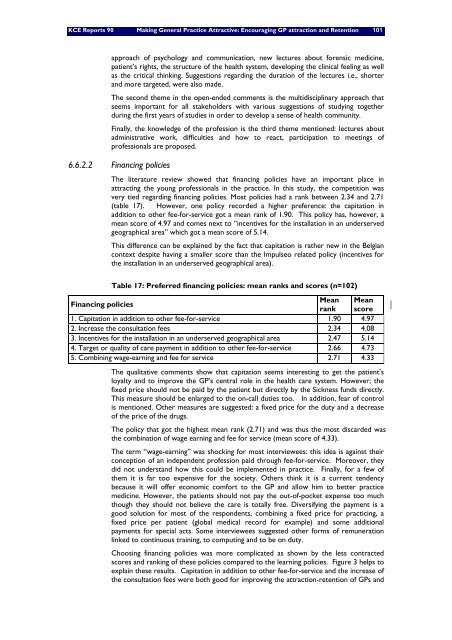Download the report (150 p.) - KCE
Download the report (150 p.) - KCE
Download the report (150 p.) - KCE
Create successful ePaper yourself
Turn your PDF publications into a flip-book with our unique Google optimized e-Paper software.
<strong>KCE</strong> Reports 90 Making General Practice Attractive: Encouraging GP attraction and Retention 101<br />
approach of psychology and communication, new lectures about forensic medicine,<br />
patient’s rights, <strong>the</strong> structure of <strong>the</strong> health system, developing <strong>the</strong> clinical feeling as well<br />
as <strong>the</strong> critical thinking. Suggestions regarding <strong>the</strong> duration of <strong>the</strong> lectures i.e., shorter<br />
and more targeted, were also made.<br />
The second <strong>the</strong>me in <strong>the</strong> open-ended comments is <strong>the</strong> multidisciplinary approach that<br />
seems important for all stakeholders with various suggestions of studying toge<strong>the</strong>r<br />
during <strong>the</strong> first years of studies in order to develop a sense of health community.<br />
Finally, <strong>the</strong> knowledge of <strong>the</strong> profession is <strong>the</strong> third <strong>the</strong>me mentioned: lectures about<br />
administrative work, difficulties and how to react, participation to meetings of<br />
professionals are proposed.<br />
6.6.2.2 Financing policies<br />
The literature review showed that financing policies have an important place in<br />
attracting <strong>the</strong> young professionals in <strong>the</strong> practice. In this study, <strong>the</strong> competition was<br />
very tied regarding financing policies. Most policies had a rank between 2.34 and 2.71<br />
(table 17). However, one policy recorded a higher preference: <strong>the</strong> capitation in<br />
addition to o<strong>the</strong>r fee-for-service got a mean rank of 1.90. This policy has, however, a<br />
mean score of 4.97 and comes next to “incentives for <strong>the</strong> installation in an underserved<br />
geographical area” which got a mean score of 5.14.<br />
This difference can be explained by <strong>the</strong> fact that capitation is ra<strong>the</strong>r new in <strong>the</strong> Belgian<br />
context despite having a smaller score than <strong>the</strong> Impulseo related policy (incentives for<br />
<strong>the</strong> installation in an underserved geographical area).<br />
Table 17: Preferred financing policies: mean ranks and scores (n=102)<br />
Financing policies<br />
Mean Mean<br />
rank score<br />
1. Capitation in addition to o<strong>the</strong>r fee-for-service 1.90 4.97<br />
2. Increase <strong>the</strong> consultation fees 2.34 4.08<br />
3. Incentives for <strong>the</strong> installation in an underserved geographical area 2.47 5.14<br />
4. Target or quality of care payment in addition to o<strong>the</strong>r fee-for-service 2.66 4.73<br />
5. Combining wage-earning and fee for service 2.71 4.33<br />
The qualitative comments show that capitation seems interesting to get <strong>the</strong> patient’s<br />
loyalty and to improve <strong>the</strong> GP’s central role in <strong>the</strong> health care system. However; <strong>the</strong><br />
fixed price should not be paid by <strong>the</strong> patient but directly by <strong>the</strong> Sickness funds directly.<br />
This measure should be enlarged to <strong>the</strong> on-call duties too. In addition, fear of control<br />
is mentioned. O<strong>the</strong>r measures are suggested: a fixed price for <strong>the</strong> duty and a decrease<br />
of <strong>the</strong> price of <strong>the</strong> drugs.<br />
The policy that got <strong>the</strong> highest mean rank (2.71) and was thus <strong>the</strong> most discarded was<br />
<strong>the</strong> combination of wage earning and fee for service (mean score of 4.33).<br />
The term “wage-earning” was shocking for most interviewees: this idea is against <strong>the</strong>ir<br />
conception of an independent profession paid through fee-for-service. Moreover, <strong>the</strong>y<br />
did not understand how this could be implemented in practice. Finally, for a few of<br />
<strong>the</strong>m it is far too expensive for <strong>the</strong> society. O<strong>the</strong>rs think it is a current tendency<br />
because it will offer economic comfort to <strong>the</strong> GP and allow him to better practice<br />
medicine. However, <strong>the</strong> patients should not pay <strong>the</strong> out-of-pocket expense too much<br />
though <strong>the</strong>y should not believe <strong>the</strong> care is totally free. Diversifying <strong>the</strong> payment is a<br />
good solution for most of <strong>the</strong> respondents, combining a fixed price for practicing, a<br />
fixed price per patient (global medical record for example) and some additional<br />
payments for special acts. Some interviewees suggested o<strong>the</strong>r forms of remuneration<br />
linked to continuous training, to computing and to be on duty.<br />
Choosing financing policies was more complicated as shown by <strong>the</strong> less contracted<br />
scores and ranking of <strong>the</strong>se policies compared to <strong>the</strong> learning policies. Figure 3 helps to<br />
explain <strong>the</strong>se results. Capitation in addition to o<strong>the</strong>r fee-for-service and <strong>the</strong> increase of<br />
<strong>the</strong> consultation fees were both good for improving <strong>the</strong> attraction-retention of GPs and
















